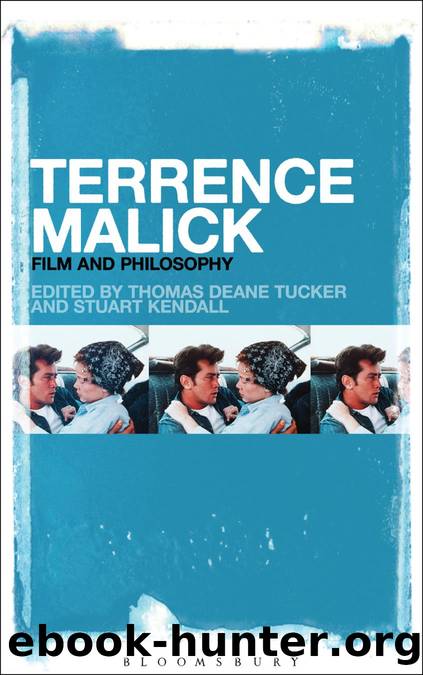Terrence Malick by Kendall Stuart.;Tucker Thomas Deane;

Author:Kendall, Stuart.;Tucker, Thomas Deane;
Language: eng
Format: epub
ISBN: 9781441148957
Publisher: Bloomsbury USA
Published: 2019-11-22T16:00:00+00:00
Notes
1See David Sterritt, “Film, Philosophy, and Terrence Malick’s The New World,” Chronicle of Higher Education, January 6, 2006, B12–13, http://web.ebscohost.com. Sterritt offers this appraisal of Malick’s career upon the highly anticipated release of The New World: “He’s fascinated with the world of nature, and he sees the personalities and behaviors of his characters as phenomena no less ‘natural’ than the environments surrounding them. The New World affords him a perfect opportunity to examine contrasts between the notion of a timeless harmony with nature, represented by American Indian society, and the post-Enlightenment idea of taming and harnessing nature to accomplish humanly determined goals, as the English Colonists do.”
2Willa Cather, My Ántonia (The Willa Cather Scholarly Edition) (Lincoln: University of Nebraska Press, 1994), 8.
3See Helen Thorpe, “The Man Who wasn’t There,” Texas Monthly, December 1998, http://web.ebscohost.com. Writing about the mixed and sometimes perplexed reception of Days of Heaven, Thorpe argues that “people who knew the movie history felt it was patched together, but others saw an epic told in a fantastically sparse style, as if some offbeat poet had brought to life a Willa Cather novel.”
4Photo-texts include The Inhabitants (1946), God’s Country and My People (1968), Love Affair—A Venetian Journal (1972), and Wright Morris: Photographs and Words (1982). Photo collections include Wright Morris: Structures and Artifacts, Photographs, 1933–54 (from the Sheldon Memorial Art Gallery show at the University of Nebraska, 1975), The Wright Morris Portfolio (1981), Time Pieces: The Photographs and Words of Wright Morris, March 16–May 15, 1983 (from an exhibition at The Corcoran Gallery of Art, Washington, D.C., 1983). Aperture Press published Time Pieces: Photographs, Writing and Memory in 1989. Morris’s most recognized combination of photography and fiction is The Home Place (1948). The San Francisco Museum of Modern Art regularly exhibits Morris’s work, noting that he “made his mark on the fields of both writing and photography—a multimedia man avant la lettre—and left a strong imprint in the Bay Area through his teaching at San Francisco State University.” In September 2010 they held a retrospective “Where was the Home Place? Wright Morris at 100” (www.sfmoma.org/events/1712).
5Two of his novels won the national book award (1957 for The Field of Vision and 1981 for Plains Song), and he was awarded a Guggenheim fellowship in photography in 1942 and 1946, as well as several awards and fellowships with the National Endowment for the Humanities (1976) and The Arts (1986), including a Life Achievement Award. See “Wright Morris” Contemporary Authors Online, February 25, (2004), http://galenet.galegroup.com:
Wright Morris was often referred to as one of America’s finest and most neglected living writers. Born near the geographical center of the nation, Morris explored and defined what it means to be American in more than forty works of fiction, photography, and criticism since 1942. Though these works received “the general indifference of the reading public,” as Jonathan Yardley noted in the Washington Post Book World, Morris garnered substantial critical acclaim and a number of coveted awards, not only for individual novels . . . but also for his life’s work.
Download
This site does not store any files on its server. We only index and link to content provided by other sites. Please contact the content providers to delete copyright contents if any and email us, we'll remove relevant links or contents immediately.
The Kite Runner by Khaled Hosseini(4472)
Gerald's Game by Stephen King(3927)
The Perils of Being Moderately Famous by Soha Ali Khan(3789)
Dialogue by Robert McKee(3592)
Story: Substance, Structure, Style and the Principles of Screenwriting by Robert McKee(2992)
The 101 Dalmatians by Dodie Smith(2940)
The Pixar Touch by David A. Price(2744)
Confessions of a Video Vixen by Karrine Steffans(2680)
Fantastic Beasts: The Crimes of Grindelwald by J. K. Rowling(2550)
How Music Works by David Byrne(2535)
Slugfest by Reed Tucker(2422)
Harry Potter 4 - Harry Potter and The Goblet of Fire by J.K.Rowling(2419)
The Mental Game of Writing: How to Overcome Obstacles, Stay Creative and Productive, and Free Your Mind for Success by James Scott Bell(2398)
Wildflower by Drew Barrymore(2121)
Scandals of Classic Hollywood: Sex, Deviance, and Drama from the Golden Age of American Cinema by Anne Helen Petersen(2114)
Casting Might-Have-Beens: A Film by Film Directory of Actors Considered for Roles Given to Others by Mell Eila(2077)
Screenplay: The Foundations of Screenwriting by Syd Field(2063)
Robin by Dave Itzkoff(2010)
The Complete H. P. Lovecraft Reader by H.P. Lovecraft(1978)
